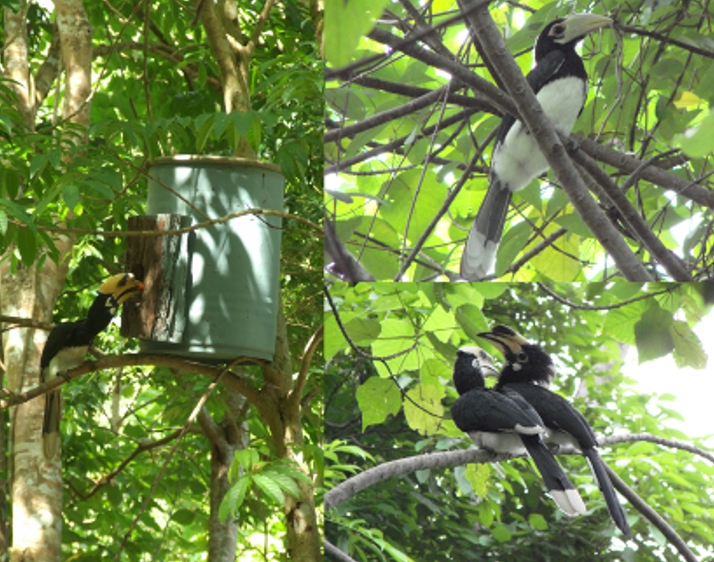การเพาะเลี้ยงและปล่อยนกแก๊กคืนสู่ธรรมชาติ

ประชากรนกเงือกถูกคุกคามเนื่องจากการลดลงของพื้นที่ป่าไม้และการเปลี่ยนแปลงถิ่นที่อยู่อาศัย การล่าเพื่อค้า และนำมาเป็นอาหารทำให้ประชากรนกเงือกหลายชนิดลดลงรวมถึงนกแก๊ก (Anthracoceros albirostris) อันจะส่งผลกระทบระหว่างนกเงือกและผลไม้ขนาดใหญ่ที่ต้องการพึ่งพิงนกเงือกในการกระจายเมล็ด จึงต้องมีโครงการเพิ่มประชากรในธรรมชาติโดยการเพาะเลี้ยงและปล่อยคืนสู่ธรรมชาติ การเพาะเลี้ยงดำเนินการที่สวนสัตว์ป่าเขาเขียว จ.ชลบุรี นกที่เลี้ยงวางไข่ช่วงเดือนกุมภาพันธ์ถึงมีนาคม ฟักเป็นตัวช่วงปลายเดือนมีนาคมและบินออกจากรังช่วงปลายเดือนเมษายน ลูกนกที่เพาะได้มีค่าเฉลี่ยสูงกว่าในธรรมชาติ (2.05 ตัวต่อคู่) ทำการปล่อยนกที่เพาะได้จำนวน 11 ตัว ในเขตรักษาพันธุ์สัตว์ป่าเขาเขียว-เขาชมภู่ พบว่านกที่ปล่อยไปคู่แรกวางไข่และฟักเป็นตัวในรังเทียมที่เตรียมไว้ให้ในเดือนเมษายน การศึกษาครั้งนี้ชี้ให้เห็นว่าการเพาะเลี้ยงและการปล่อยคืนสู่ธรรมชาติมีแนวโน้มที่สำคัญต่อการเพิ่มประชากรนกแก๊กในธรรมชาติได้

The major threats to hornbill populations are deforestation and habitat modification. Unsustainable hunting for the live bird trade and for food can deplete populations of many species of hornbill, including the Oriental pied hornbill (Anthracoceros albirostris). The decreased number of hornbills will likely disrupt mutualisms between hornbills and some large-seeded food plants and decrease the opportunity of large-seeded food plants to move to special microsites favorable for establishment. The captive breeding and reintroduction of the Oriental pied hornbill can increase its population in the natural habitats. Oriental pied hornbills were bred in Khao Kheow Open Zoo, Chonburi province. Eggs were laid and incubated between February and March. Nestlings hatched in late March and left the nest in late April. Fledglings per pair were higher than report in the natural habitat of Thailand (2.05 fledglings/pair). Eleven birds were reintroduced in Khao Kheow-Khao Chompu Wildlife Sanctuary. The first reintroduced pair was able to breed naturally by laying and hatching eggs in an artificial nest. Two juveniles left the nest in April 2008. These results indicate that both captive breeding and reintroduction are potentially important ways to increase the population of the Oriental pied hornbill in natural habitats.
ที่มา: การเพาะเลี้ยงและการปล่อยนกแก๊ก (Anthracoceros albirostris) คืนสู่ธรรมชาติเพื่อฟื้นฟูประชากรในเขตรักษาพันธุ์สัตว์ป่าเขาเขียว-เขาชมภู่ โดย รัตนวัฒน์ ไชยรัตน์ อุฬาริกา กองพรหม ดาริกา มานะธรรมกมล สุนันท์ แหวนประดับ และเสถียร สง่าแรง
